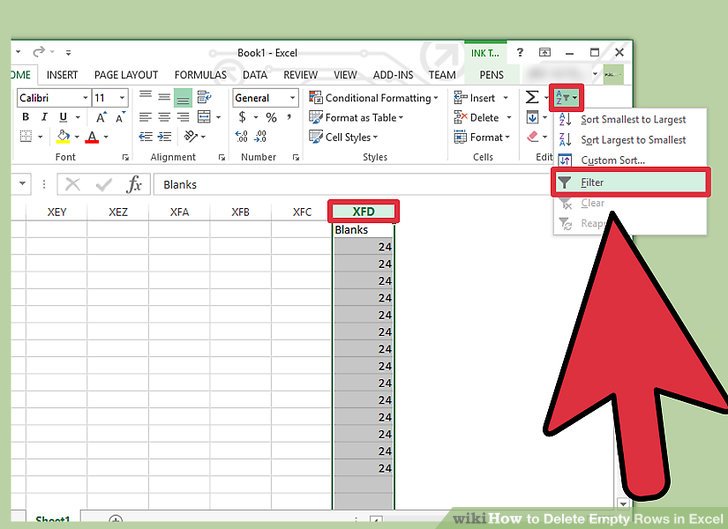Excel Ninja: Obliterate Blank Rows in Seconds!
Tired of scrolling through endless spreadsheets cluttered with empty rows? Imagine cleaning up those pesky gaps in mere seconds. No more tedious manual deletion – we're talking ninja-level Excel skills here. This article is your guide to mastering the art of swiftly eliminating blank rows in your spreadsheets, boosting your productivity and reclaiming valuable time.
Dealing with blank rows in Excel is a common struggle. They often result from importing data, copying and pasting, or simply deleting cell content without removing the entire row. These empty rows not only make your spreadsheet look messy but also hinder analysis and can cause issues with formulas and sorting. Luckily, Excel offers several ways to banish these empty rows, ranging from manual deletion to powerful shortcuts.
While manual deletion works, it's painfully slow, especially with large datasets. This is where the magic of Excel shortcuts comes into play. Learning these shortcuts is essential for anyone who regularly works with Excel. These key combinations can dramatically speed up your workflow, allowing you to focus on analysis rather than tedious cleanup.
The history of these shortcuts is intertwined with the evolution of Excel itself. As spreadsheets became larger and more complex, the need for efficient ways to manage data became crucial. Microsoft introduced keyboard shortcuts as a way to streamline common tasks, including deleting rows, and these shortcuts have become integral to efficient spreadsheet management.
One of the core issues surrounding blank row deletion is accidental data loss. While shortcuts offer speed, a misplaced click can lead to unintended consequences. Therefore, understanding the nuances of each method, including its potential pitfalls, is vital. This includes being aware of how hidden rows might be affected and ensuring data integrity before performing any deletion operation.
Let's explore the powerful shortcut: Ctrl + - (minus sign). This keyboard combination allows you to delete entire rows in one swift move. Select the rows you wish to remove, press Ctrl and the minus sign key simultaneously, and poof! The empty rows vanish. This method is arguably the quickest for removing multiple non-contiguous rows.
Benefits of Using Shortcuts:
1. Time Savings: Eliminating blank rows with shortcuts is significantly faster than manual deletion, particularly for large datasets.
2. Improved Efficiency: Streamlining this task frees up time for more critical spreadsheet activities like data analysis and formula creation.
3. Enhanced Professionalism: Clean, organized spreadsheets present a more professional image, making your work easier to understand and navigate.
Step-by-Step Guide:
1. Select the entire rows containing the blank rows you want to delete.
2. Press Ctrl and the minus sign (-) key together.
3. Confirm the deletion in the dialog box that appears.
Best Practices:
1. Always save a copy of your spreadsheet before undertaking bulk deletions.
2. Double-check your selection to avoid accidental deletion of crucial data.
3. Utilize the "Find & Select" feature to quickly locate blank rows.
4. Consider using filters to isolate blank rows before applying the shortcut.
5. Practice the shortcut on a test spreadsheet until you are comfortable with its use.
Real-World Examples: Imagine cleaning customer data with hundreds of blank entries, preparing financial reports, or analyzing sales figures - these shortcuts are invaluable in any scenario needing quick spreadsheet cleanup.
Advantages and Disadvantages
| Advantages | Disadvantages |
|---|---|
| Fast and Efficient | Potential for Accidental Deletion |
| Improves Spreadsheet Organization | Requires Understanding of Shortcut Keys |
FAQ:
Q: What if I accidentally delete the wrong rows?
A: Use the "Undo" function (Ctrl + Z) immediately.
Q: Can I use this shortcut with hidden rows?
A: Yes, hidden rows within your selection will also be deleted.
Q: Are there other ways to delete blank rows?
A: Yes, you can use the "Go To Special" dialog box, filtering, or VBA macros.
Q: Does this shortcut work on Mac?
A: On a Mac, the equivalent shortcut is Command + -.
Q: What if Ctrl + - doesn't work?
A: Check your keyboard settings or try a different shortcut method.
Q: Can I use this with non-contiguous rows?
A: Yes, select all desired rows, even if they are not next to each other.
Q: Does deleting rows shift formulas?
A: Yes, deleting rows can affect formulas that reference the deleted cells. Be cautious and review formulas after deleting rows.
Q: Can I recover deleted rows after saving?
A: It may be difficult. Consider using version history or file recovery software.
Tips and Tricks: Combine the Ctrl + - shortcut with the Find & Select function for maximum efficiency. This allows you to pinpoint all blank cells and then select their entire rows before using the shortcut.
Mastering the art of swiftly deleting blank rows in Excel is a game-changer for anyone who regularly works with spreadsheets. It not only saves valuable time and increases efficiency but also contributes to creating more organized and professional-looking documents. By learning and applying the Ctrl + - shortcut, along with other techniques discussed, you empower yourself to manage your data more effectively. While accidental deletions are a potential risk, practicing these techniques and adhering to best practices, such as saving backups and double-checking selections, minimizes this risk. Embrace the power of Excel shortcuts and unlock a new level of spreadsheet mastery. Start cleaning up your spreadsheets today and experience the difference!
Saving our planet powerful ideas for environmental preservation karangan usaha melestarikan alam sekitar
Mdr jetzt im programm your guide to german tv gold
Dominate week 17 conquer your fantasy football ppr league












